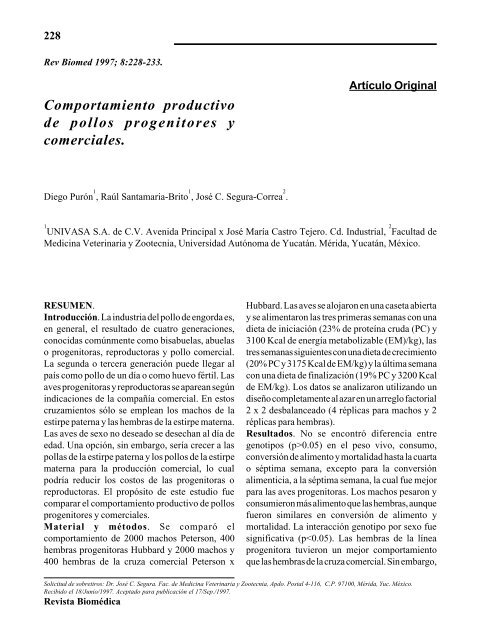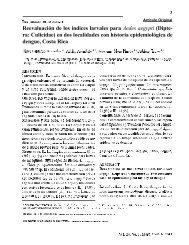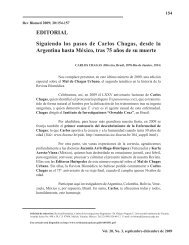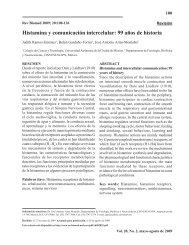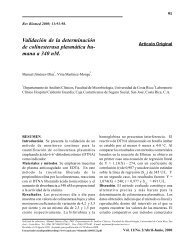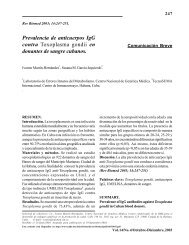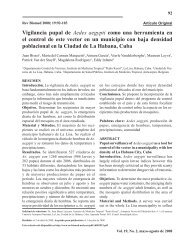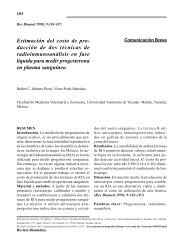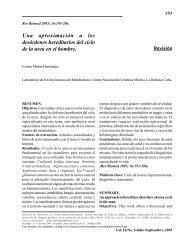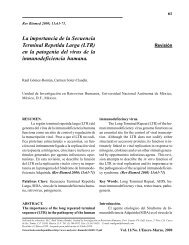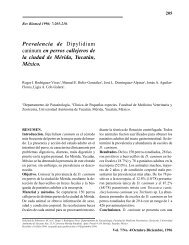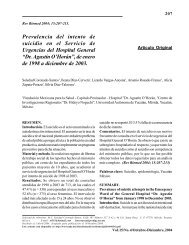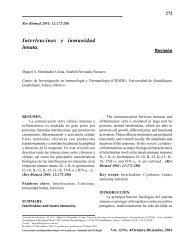Comportamiento productivo de pollos progenitores y comerciales.
Comportamiento productivo de pollos progenitores y comerciales.
Comportamiento productivo de pollos progenitores y comerciales.
Create successful ePaper yourself
Turn your PDF publications into a flip-book with our unique Google optimized e-Paper software.
228<br />
Rev Biomed 1997; 8:228-233.<br />
<strong>Comportamiento</strong> <strong>productivo</strong><br />
<strong>de</strong> <strong>pollos</strong> <strong>progenitores</strong> y<br />
<strong>comerciales</strong>.<br />
Artículo Original<br />
Diego Purón 1 , Raúl Santamaria-Brito 1 , José C. Segura-Correa 2 .<br />
1<br />
UNIVASA S.A. <strong>de</strong> C.V. Avenida Principal x José María Castro Tejero. Cd. Industrial,<br />
2<br />
Facultad <strong>de</strong><br />
Medicina Veterinaria y Zootecnia, Universidad Autónoma <strong>de</strong> Yucatán. Mérida, Yucatán, México.<br />
RESUMEN.<br />
Introducción. La industria <strong>de</strong>l pollo <strong>de</strong> engorda es,<br />
en general, el resultado <strong>de</strong> cuatro generaciones,<br />
conocidas comúnmente como bisabuelas, abuelas<br />
o progenitoras, reproductoras y pollo comercial.<br />
La segunda o tercera generación pue<strong>de</strong> llegar al<br />
país como pollo <strong>de</strong> un día o como huevo fértil. Las<br />
aves progenitoras y reproductoras se aparean según<br />
indicaciones <strong>de</strong> la compañía comercial. En estos<br />
cruzamientos sólo se emplean los machos <strong>de</strong> la<br />
estirpe paterna y las hembras <strong>de</strong> la estirpe materna.<br />
Las aves <strong>de</strong> sexo no <strong>de</strong>seado se <strong>de</strong>sechan al día <strong>de</strong><br />
edad. Una opción, sin embargo, sería crecer a las<br />
pollas <strong>de</strong> la estirpe paterna y los <strong>pollos</strong> <strong>de</strong> la estirpe<br />
materna para la producción comercial, lo cual<br />
podría reducir los costos <strong>de</strong> las progenitoras o<br />
reproductoras. El propósito <strong>de</strong> este estudio fue<br />
comparar el comportamiento <strong>productivo</strong> <strong>de</strong> <strong>pollos</strong><br />
<strong>progenitores</strong> y <strong>comerciales</strong>.<br />
Material y métodos. Se comparó el<br />
comportamiento <strong>de</strong> 2000 machos Peterson, 400<br />
hembras progenitoras Hubbard y 2000 machos y<br />
400 hembras <strong>de</strong> la cruza comercial Peterson x<br />
Hubbard. Las aves se alojaron en una caseta abierta<br />
y se alimentaron las tres primeras semanas con una<br />
dieta <strong>de</strong> iniciación (23% <strong>de</strong> proteína cruda (PC) y<br />
3100 Kcal <strong>de</strong> energía metabolizable (EM)/kg), las<br />
tres semanas siguientes con una dieta <strong>de</strong> crecimiento<br />
(20% PC y 3175 Kcal <strong>de</strong> EM/kg) y la última semana<br />
con una dieta <strong>de</strong> finalización (19% PC y 3200 Kcal<br />
<strong>de</strong> EM/kg). Los datos se analizaron utilizando un<br />
diseño completamente al azar en un arreglo factorial<br />
2 x 2 <strong>de</strong>sbalanceado (4 réplicas para machos y 2<br />
réplicas para hembras).<br />
Resultados. No se encontró diferencia entre<br />
genotipos (p>0.05) en el peso vivo, consumo,<br />
conversión <strong>de</strong> alimento y mortalidad hasta la cuarta<br />
o séptima semana, excepto para la conversión<br />
alimenticia, a la séptima semana, la cual fue mejor<br />
para las aves progenitoras. Los machos pesaron y<br />
consumieron más alimento que las hembras, aunque<br />
fueron similares en conversión <strong>de</strong> alimento y<br />
mortalidad. La interacción genotipo por sexo fue<br />
significativa (p
229<br />
Producción <strong>de</strong> <strong>pollos</strong> <strong>de</strong> engorda.<br />
los machos <strong>de</strong> la cruza comercial se comportaron<br />
mejor que aquellos <strong>de</strong> la línea progenitora.<br />
Discusión. Los resultados <strong>de</strong> este estudio podrían<br />
beneficiar al productor al obtener ingresos extras<br />
por el crecimiento <strong>de</strong> las hembras <strong>de</strong> <strong>de</strong>secho <strong>de</strong> las<br />
hembras progenitoras <strong>de</strong> la línea paterna.<br />
Palabras clave: pollo <strong>de</strong> engorda, avicultura.<br />
SUMMARY.<br />
Productive behaviour of progenitor and<br />
commercial chickens.<br />
Introduction. The broiler industry is, in general, a<br />
product of 4 generations of chickens known as:<br />
great-grandparents, grandparents, parents and<br />
commercials. The grandparent and parent birds<br />
arrive to Mexico as fertil eggs or day old chicks.<br />
The grandparent and parent birds are mated<br />
according to the indications of the breeding<br />
company. Only males of the male grandparent line<br />
or females of the female grandparent line can be<br />
kept for mating. One option could be to rear the<br />
female of the male grandparent line and the males of<br />
the female grandparent lines as commercial broilers,<br />
which could reduce the cost of the grandparent<br />
birds. The objetive of this study was to compare the<br />
performance of grandparent’s males and females<br />
and commercial broilers.<br />
Material and methods. The performance of 2000<br />
Peterson broiler males and 400 Hubbard females<br />
from a grandparent line and 2000 males and 400<br />
females from the commercial cross Peterson x<br />
Hubbard were compared. Broilers were kept in an<br />
open house and were fed the first three weeks with<br />
a starter diet (23% cru<strong>de</strong> protein (CP) and 3100<br />
Kcal of metabolized energy (ME)/kg). The next<br />
three weeks with a grower diet (20% CP and 3175<br />
Kcal of ME/kg) and the last week with a finisher<br />
diet (19% CP and 3200 Kcal of ME/kg). Data were<br />
analyzed in a 2 x 2 factorial unbalance complete<br />
randomized <strong>de</strong>sign (4 replicates for males and 2<br />
replicates for females).<br />
Results. There were no differences among<br />
genotypes (p>0.05) on body weight, feed<br />
consumption, feed conversion and mortality, up to<br />
4 or 7 seven weeks of age, except for feed conversion<br />
up to 7 weeks, which was better for the grand<br />
parent broilers. Male broilers weighed more and<br />
had a higher consumption of feed than females.<br />
Although there were no differences in feed<br />
conversion and mortality at 4 and 7 weeks. The<br />
genotype by sex interaction was significant (p
230<br />
D Purón, R Santamaría-Brito, JC Segura-Correa.<br />
AC se aparean con los machos <strong>de</strong> las reproductoras<br />
BD para producir la cuarta generación, el pollo<br />
comercial que es un híbrido producto <strong>de</strong> la cruza<br />
<strong>de</strong> cuatro estirpes. Es común también el apareamiento<br />
<strong>de</strong> hembras <strong>de</strong> estirpes maternas <strong>de</strong><br />
progenitoras o reproductoras <strong>de</strong> una compañía con<br />
machos <strong>de</strong> estirpes paternas <strong>de</strong> otra compañía (p.e.,<br />
la cruza Peterson x Hubbard <strong>de</strong> uso común en<br />
Yucatán, México). Cabe mencionar que la segunda<br />
o tercera generación llega al país como pollo<br />
<strong>de</strong> un día o como huevo fértil. Es importante señalar<br />
también que en los cruzamientos <strong>de</strong> la segunda<br />
y tercera generación sólo se emplean los<br />
machos <strong>de</strong> la estirpe paterna y las hembras <strong>de</strong> la<br />
estirpe materna, pero no ambos sexos. Las aves<br />
<strong>de</strong> sexo no <strong>de</strong>seado se <strong>de</strong>sechan al día <strong>de</strong> edad, a<br />
través <strong>de</strong>l sexado <strong>de</strong> los <strong>pollos</strong>. Sin embargo, una<br />
opción es crecer a los <strong>pollos</strong> <strong>progenitores</strong> <strong>de</strong> <strong>de</strong>secho<br />
como pollo comercial, lo cual podría reducir<br />
los costos <strong>de</strong> las progenitoras, siempre y cuando<br />
estos <strong>pollos</strong> muestren un comportamiento similar<br />
o mejor a la <strong>de</strong> los <strong>pollos</strong> <strong>comerciales</strong>.<br />
El propósito <strong>de</strong> este estudio fue comparar el<br />
comportamiento <strong>productivo</strong> <strong>de</strong> <strong>pollos</strong> (machos y<br />
hembras) <strong>progenitores</strong> y pollo comercial Peterson<br />
x Hubbard, es <strong>de</strong>cir <strong>pollos</strong> <strong>de</strong> la segunda vs la cuarta<br />
generación.<br />
Revista Biomédica<br />
MATERIAL Y MÉTODOS.<br />
El trabajo se realizó en la Granja experimental<br />
<strong>de</strong> UNIVASA localizada en el Municipio <strong>de</strong><br />
Seyé Yucatán, México a 9 msnm. El clima <strong>de</strong> la<br />
región es tropical subhúmedo con lluvias en verano<br />
(3). Los promedios <strong>de</strong> temperatura y humedad<br />
relativa para la zona son <strong>de</strong> 26°C y 75%, respectivamente.<br />
Se utilizaron 2400 aves progenitoras (2000<br />
machos Peterson y 400 hembras Hubbard) y 2400<br />
aves (2000 machos y 400 hembras) <strong>de</strong> la cruza<br />
comercial Peterson x Hubbard. Las aves se alojaron<br />
en 24 corraletas <strong>de</strong> 20 m 2 (4m x 5m) con 200<br />
<strong>pollos</strong> cada una en una caseta abierta con techo <strong>de</strong><br />
láminas <strong>de</strong> cindú y piso <strong>de</strong> cemento con ventiladores<br />
<strong>de</strong> techo y cama <strong>de</strong> cascarilla <strong>de</strong> arroz. Las aves<br />
se alimentaron una vez al día durante las tres primeras<br />
semanas con una dieta <strong>de</strong> iniciación (23%<br />
<strong>de</strong> proteína cruda (PC) y 3100 Kcal <strong>de</strong> energía<br />
metabolizable (EM)/kg), las siguientes tres semanas<br />
con una dieta <strong>de</strong> crecimiento (20% PC y 3175<br />
Kcal <strong>de</strong> EM/kg) y la última semana con una dieta<br />
<strong>de</strong> finalización (19% PC y 3200 Kcal <strong>de</strong> EM/kg).<br />
El alimento ofrecido se pesó y registró diariamente.<br />
Los animales tuvieron agua a libertad y se vacunaron<br />
contra la enfermedad <strong>de</strong> Newcastle a los<br />
8 días <strong>de</strong> edad.<br />
Cada semana se pesaba el 10% <strong>de</strong> los animales<br />
vivos, excepto la cuarta y séptima semana<br />
en las cuales se pesó el total <strong>de</strong> ellos. Diariamente<br />
se registraba el número y peso <strong>de</strong> las aves muertas<br />
por corral para calcular la conversión <strong>de</strong> alimento<br />
ajustada.<br />
Las variables estudiadas fueron: el peso corporal,<br />
el consumo <strong>de</strong> alimento, la conversión ajustada<br />
y mortalidad a las 4 y 7 semanas <strong>de</strong> edad <strong>de</strong><br />
los <strong>pollos</strong> (machos y hembras).<br />
Los datos se analizaron utilizando un diseño<br />
completamente al azar en un arreglo factorial 2 x<br />
2 <strong>de</strong>sbalanceado (4 réplicas para los machos y 2<br />
réplicas para las hembras por tratamiento). Los<br />
factores fueron sexo (machos y hembras) y<br />
genotipo (progenitoras y pollo comercial). Los<br />
análisis estadísticos se hicieron utilizando el programa<br />
SAS (4). Los datos <strong>de</strong> mortalidad se transformaron<br />
a arcoseno raíz cuadrada antes <strong>de</strong>l análisis<br />
<strong>de</strong> varianza (5).<br />
RESULTADOS.<br />
Los resultados obtenidos a la cuarta semana<br />
<strong>de</strong> edad se presentan en el cuadro 1. No se encontró<br />
diferencia significativa (p>0.05) entre genotipos<br />
para ninguna <strong>de</strong> las variables <strong>de</strong> respuesta estudiadas.<br />
Sin embargo, se encontró efecto <strong>de</strong> sexo y <strong>de</strong> la<br />
interacción genotipo por sexo. Los machos pesaron<br />
y consumieron significativamente (p
231<br />
Producción <strong>de</strong> <strong>pollos</strong> <strong>de</strong> engorda.<br />
Cuadro 1<br />
Medias <strong>de</strong>l comportamiento <strong>productivo</strong> <strong>de</strong> la progenie macho y hembra <strong>de</strong> progenitoras y <strong>de</strong><br />
pollo <strong>de</strong> engorda Peterson x Hubbard a los 28 días <strong>de</strong> edad.<br />
Peso Consumo Conversión Mortalidad<br />
(g) (g) (%)<br />
GENOTIPO:<br />
Comercial (C) 1106.3a 1830.7a 1.66a 2.49a<br />
Progenitora(P) 1115.3a 1806.2a 1.62a 1.94a<br />
SEXO:<br />
Hembra(H) 1059.5a 1747.8a 1.65a 1.99a<br />
Macho(M) 1162.1b 1889.2b 1.62a 2.44a<br />
TRATAMIENTO:<br />
CH 1006.0a 1704.5a 1.69c 2.75a<br />
CM 1206.6c 1956.9c 1.62b 2.25a<br />
PH 1113.0b 1791.0a 1.61ab 1.25a<br />
PM 1117.6b 1821.4b 1.63b 2.65a<br />
a,b,c Medias en columnas con distinta literal son diferentes (p0.05) en las variables <strong>de</strong> respuestas, excepto<br />
para la conversión <strong>de</strong> alimento, el cual fue mejor<br />
para las progenitoras. Así mismo, los machos<br />
pesaron más que las hembras, pero tuvieron un<br />
mayor consumo <strong>de</strong> alimento, razón por la cual no<br />
se encontró diferencia en la conversión <strong>de</strong> alimento<br />
(p>0.05). Tampoco se encontró efecto <strong>de</strong> sexo en<br />
la mortalidad. La interacción genotipo por sexo fue<br />
significativa (p
232<br />
D Purón, R Santamaría-Brito, JC Segura-Correa.<br />
Cuadro 2<br />
Medias <strong>de</strong>l comportamiento <strong>productivo</strong> <strong>de</strong> la progenie macho y hembra <strong>de</strong> progenitoras<br />
y <strong>de</strong> pollo <strong>de</strong> engorda Peterson x Hubbard hasta los 49 días <strong>de</strong> edad.<br />
Peso Consumo Conversión Mortalidad<br />
(g) (g) (%)<br />
GENOTIPO:<br />
Comercial (C) 2203.2a 4687.5a 2.12a 4.45a<br />
Progenitora(P) 2221.0a 4584.3a 2.06b 4.47a<br />
SEXO:<br />
Hembra(H) 2058.0a 4311.7a 2.07a 3.37a<br />
Macho(M) 2366.2b 4960.1b 2.11a 5.54a<br />
TRATAMIENTO:<br />
CH 1968.5a 4292.5a 2.14b 3.00a<br />
CM 2438.0d 5083.1c 2.10b 5.90a<br />
PH 2147.5b 4331.5a 2.01a 3.75a<br />
PM 2294.5c 4837.1b 2.10b 5.20a<br />
a,b,c,d Medias en columnas con distinta literal son diferentes (p
233<br />
Producción <strong>de</strong> <strong>pollos</strong> <strong>de</strong> engorda.<br />
2.- Cahaner A, Siegel PB. Evaluation of industry breeding<br />
programs for meat-type chickens and turkeys. 3rd World<br />
Congress on Genetics Applied to Livestock Production. X.<br />
Breeding programs for swine, poultry and fish. Nebraska:<br />
Lincoln, 1986: 201-213.<br />
3.- García E. Modificaciones al Sistema <strong>de</strong> Clasificación<br />
Climática <strong>de</strong> Koppen. México: Instituto <strong>de</strong> Geografía,<br />
Universidad Autónoma <strong>de</strong> México, 1973: 1-246.<br />
4.- SAS/STAT User’s Gui<strong>de</strong>, Version 6, Fourth edition, Vol<br />
2 Cary: SAS Institute Inc. 1989:891-996.<br />
5.- Steel RGD, Torrie JH. Bioestadística: Principios y<br />
Procedimientos. 2a. ed. México, D.F: McGraw-Hill, 1985:<br />
226-230.<br />
6.- Falconer DS. Introduction to Quantitative Genetics. 2nd<br />
ed. London and New York: Longman, 1981: 148-169.<br />
7.- Fairfull RW, Gowe RS. Use of breed resources for poultry<br />
egg and meat production. 3rd World Congress on Genetics<br />
Applied to Livestock Production. X. Breeding programs for<br />
swine, poultry and fish. Lincoln, Nebraska. 1986: 242-256.<br />
Vol. 8/No. 4/Octubre-Diciembre, 1997


